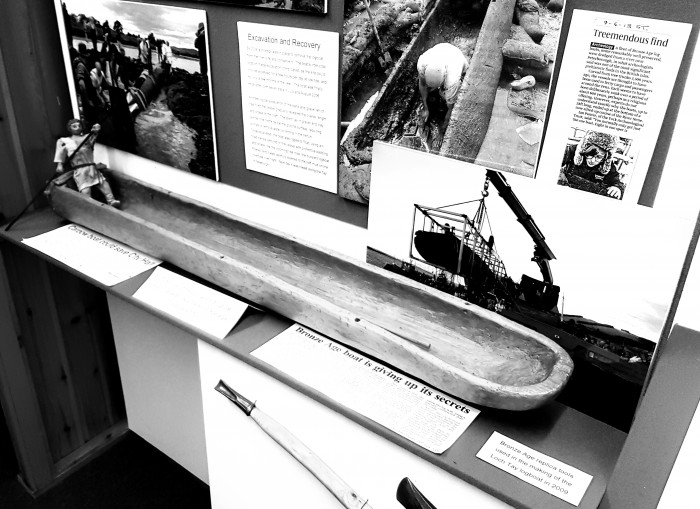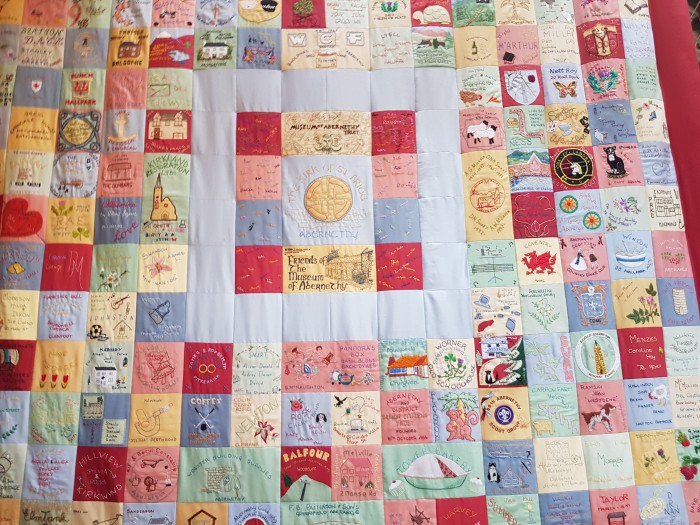×
When my girlfriend Jo and I moved to Abernethy at the end of last year we had no idea it was such a historically interesting little place. Sure, we had a vague inkling that the famous 11th century Abernethy Round Tower was very rare and unusual (turns out is one of only two in Scotland), and Jo even said she thought she saw some Pictish stones when she was walking our dog, Millie. Turns out Abernethy is brimming with more history than a DVD Turns out Abernethy is brimming with more history than a DVD boxed set of 'Time Team'. boxed set of 'Time Team'.
It was November when we moved to Abernethy and the museum, located on School Wynd opposite the Berryfields tearoom, was closed for the winter season. I was looking forward to spending a couple of hours there when it re-opened and finally made it along last Sunday with the vague notion that I could write a wee article about it if it turned out to be interesting. When I got there I was really thrilled with the quality of the exhibitions and the information that accompanies them.
Just as you walk in the museum there are two parallel historical timelines, one for Scotland and one  for Abernethy. It makes a great primer for what you are about to see in the museum and it is amazing to see that plays such a pivotal part in so much of Scotland's history. It all starts with the Carpow logboat, dating to around 2000bc it is one of the oldest and best-preserved fishing boats in Scotland. Discovered by a metal detectorist just a few short miles from Abernethy, it isn't actually housed in Abernethy Museum but there is a wealth of information on it.
for Abernethy. It makes a great primer for what you are about to see in the museum and it is amazing to see that plays such a pivotal part in so much of Scotland's history. It all starts with the Carpow logboat, dating to around 2000bc it is one of the oldest and best-preserved fishing boats in Scotland. Discovered by a metal detectorist just a few short miles from Abernethy, it isn't actually housed in Abernethy Museum but there is a wealth of information on it.
There is also information and exhibits from Abernethy's time as a Pictish capital, not least three amazingly well-preserved Pictish stones which now feature at the centre of an enhanced display area in the Museum. The stones are mounted upright on plinths, with LED lights directed onto the stones in order to enhance their markings. Accompanying the stones is a new display board providing information about the Picts, focussing on Abernethy and its own Pictish stones.
20th Century history is exceedingly well represented too. For example, I had absolutely no idea that on the same day in October 1909, both Winston Churchill and the suffragette Adela Pankhurst were both in Abernethy. Churchill, a Dundee MP at the time, had been persuaded by local businessman, George K Smith, to give a speech on the grounds of his Ballomill estate. Trains were laid on from Perth and Dundee. Churchill, already a master orator gave a 70-minute speech to a crowd of more than 2000 which Adela Pankhurst and a band of activist tried to disrupt. By all accounts they were unsuccessful, getting nowhere near Churchill and I had absolutely no idea that on the same day in October 1909, both Winston Churchill and the suffragette Adela Pankhurst were both in Abernethy. pelted with mud by the enthusiastic crowd. Weirdly, from the information I can find online, it appears that the speech took place not far away from where our house has since been built.
This might all sound a little heavy going but there is plenty of fun stuff too, with plenty of activities for kids (and big kids) like an amazing virtual reality headset that you can use to explore ancient Abernethy in stunningly rendered 3D. Truth be told, I had a mild hangover and needed to get a little bit of air after hanging out for too long in virtual Abernethy. Luckily there is a tranquil little garden to the rear of the museum where you can soak up the rays while you learn about the area's fishing and agricultural industry.
I had a great time at the museum and the only real downside is the myth-busting revelation (spoiler alert!) that buttery of all biscuits, the mighty Abernethy, isn't actually from Abernethy at all. It was a bit of a shock, but I guess as long as they still sell them in the village shop I can live with that. After looking around the museum I was able to catch up with some of the volunteers who work there for a chat.
When did the museum first open?
The Museum of Abernethy was opened in May 2000 by Magnus Magnusson (the Icelandic born scholar and TV personality of 'Mastermind' fame) and has held the Visit Scotland four  stars award since 2001.
stars award since 2001.
The building, which stands within the lands of the old Culdees monastery, dates from the eighteenth century. Originally consisting of a byre, stable and cattle rede, it was renovated during the 1990s to house the Museum. In keeping with the aim of preserving the building’s heritage, some of the original features, such as the internal stone walls and an area of cobbled floor, have been left visible.
In addition, the museum also records the memories of local inhabitants and is building a photographic record of the village, its inhabitants and their various occupations.
An added attraction is the secluded courtyard garden, where there are further displays on local agriculture, fishing and 'the berries'. It offers a peaceful area to sit and relax.
Why is Abernethy historically important?
Abernethy is a historic settlement, having been occupied since Pictish times, and the aim of the Museum is to preserve as much as possible of this varied and extensive history. For example, three of several Abernethy Pictish carved stones are on display in our museum.
In 1072 Abernethy was the site of a meeting between the King of Scots, Malcolm Canmore, and William of Normandy (who had recently conquered England). In a show of force, William brought a fleet of ships up the River Tay, and Malcolm made an oath of loyalty to the English ruler. Exactly what Malcolm believed he was promising is still debated by historians.
At this time Abernethy was an important religious centre, and home to a community of Culdees or Céli Dé (which means 'client of God' in Gaelic). The Culdees were Christian holy We are thrilled that we now have a Virtual Reality reconstruction which represents how Abernethy may have looked in the 1070s.men who followed a form of religious life developed in Ireland during the Early Middle Ages.
We are thrilled that we now have a Virtual Reality reconstruction which represents how Abernethy may have looked in the 1070s. It shows the tower, church, and dwellings of the Culdees and their tenants. It was created by the University of St Andrews and Smart History, in collaboration with the Tay Landscape Partnership and Perth and Kinross Heritage Trust. The reconstruction was inspired by the study of the extant round tower and its surroundings, and comparison with early monastic sites in Ireland (including Downpatrick, Devenish, and Glendalough). Abernethy’s Round Tower is one of only two such towers in Scotland. You can see a little taster of this exhibition here.
The collection also includes artefacts and information relating to the Parish of Abernethy from the days of the Bronze Age logboat recovered nearby in 2007, the Roman legionary fortress at Carpow, Abernethy as Pictish capital, an important religious centre during early Christian times—and so on through the First World War down to the Second World War when Abernethy was home to many Polish troops and children evacuated from cities.
Where do you get your exhibits from?
All our exhibits are collected locally, as donations usually, as the museum can only display artefacts from Abernethy and the parish of Abernethy.
Is there anything you have learned about Abernethy since starting your role that has surprised you?
The varied and interesting history of Abernethy is fascinating, from the 3000 year old Logboat, the Castlelaw Hill Fort, the Romans, the Picts, Malcolm Canmore meeting William the Conqueror in 1072, the Culdees and Augustinians in the Middle Ages through to Winston Churchill attending a meeting of 2000 people in Abernethy in 1909, the effects of the First and Second World Wars all of which is very surprising history for a small village in Perthshire.
How does the Museum of Abernethy differ from a big city museum?
It is small cosy and personal. Everyone gets a warm, friendly welcome and help if they require or not if they don’t.
***
The Museum of Abernethy is run by volunteers and is funded by donations, membership fees, fundraising and grants. The museum is open from May to September and more information can be found on their website here.
A Story of Food Poverty, Charity and Working Together
June 17th Wednesday 2020
Hayley is raising funds for Clic Sargent, the Children’s Cancer charity that supported her since she was diagnosed with a rare brain tumour.
June 4th Thursday 2020
Join The Debate Night Audience in Perth
May 18th Monday 2020